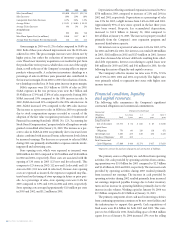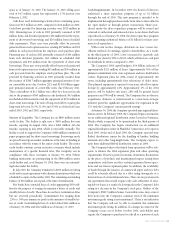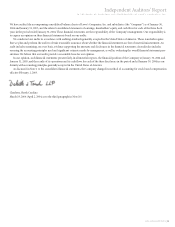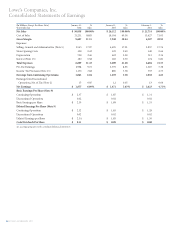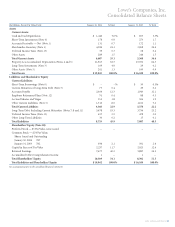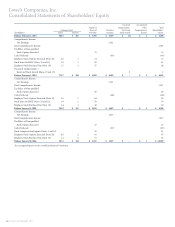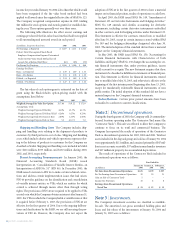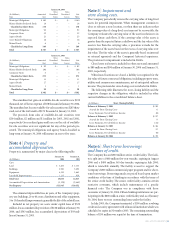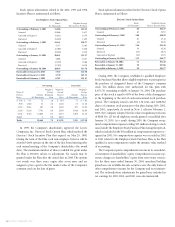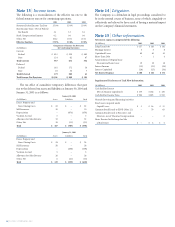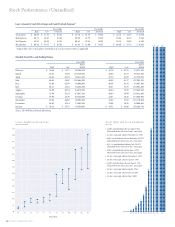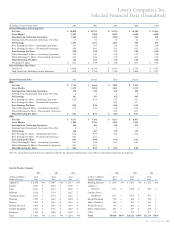Lowe's 2003 Annual Report Download - page 33
Download and view the complete annual report
Please find page 33 of the 2003 Lowe's annual report below. You can navigate through the pages in the report by either clicking on the pages listed below, or by using the keyword search tool below to find specific information within the annual report.
2003 ANNUAL REPORT 31
flows and the fair value of the assets is less than the carrying value,
a provision is made for the impairment of the assets based on the
excess of carrying value over fair value.
When a leased location is closed, a provision is made for the fair
value of future contractual obligations, including property taxes,
utilities, and common area maintenance, net of anticipated sub-
lease income. Provisions for impairment and store closing costs are
included in selling, general and administrative expenses (SG&A).
Leases Assets under capital leases are amortized in accordance
with the Company’s normal depreciation policy for owned assets or
over the lease term, if shorter, and the charge to earnings is includ-
ed in depreciation expense in the consolidated financial statements.
Self-Insurance The Company is self-insured for certain losses
relating to worker’s compensation, automobile, property, general
and product liability claims. The Company has stop loss coverage
to limit the exposure arising from these claims. Self-insurance
claims filed and claims incurred but not reported are accrued
based upon management’s estimates of the discounted aggregate
liability for uninsured claims incurred using actuarial assumptions
followed in the insurance industry and historical experience.
Although management believes it has the ability to adequately
record estimated losses related to claims, it is possible that actual
results could differ from recorded self-insurance liabilities.
Income Taxes Income taxes are provided for temporary dif-
ferences between the tax and financial accounting bases of assets
and liabilities using the asset and liability method. The tax effects
of such differences are reflected in the balance sheet at the enacted
tax rates expected to be in effect when the differences reverse.
Store Opening Costs Costs of opening new or relocated retail
stores are charged to operations as incurred.
Revenue Recognition The Company recognizes revenues
when sales transactions occur and customers take possession of the
merchandise. A provision for anticipated merchandise returns is
provided in the period that the related sales are recorded.
Revenues from product installation services are recognized
when the installation is completed. Revenues from gift cards are
deferred and recognized when the cards are redeemed.
Advertising Costs associated with advertising are charged to
operations as incurred. Gross advertising expenses were $682 mil-
lion, $608 million and $519 million in 2003, 2002 and 2001, respec-
tively. Cooperative advertising vendor funds of $673 million, $583
million and $481 million in 2003, 2002 and 2001, respectively were
recorded as a reduction of these expenses with the net amount
included in SG&A.
Vendor Funds The Company receives funds from vendors in
the normal course of business for a variety of reasons including
purchase-volume-related rebates, defective merchandise allowances,
cooperative advertising allowances, reimbursement for selling
expenses, displays and third-party, in-store service related costs.
The Company has historically treated volume-related discounts or
rebates as a reduction of inventory cost and reimbursements of
operating expenses received from vendors as a reduction of those
specific expenses. The Company’s historical accounting treatment
for these vendor provided funds is consistent with Emerging Issues
Task Force (EITF) 02-16 with the exception of certain cooperative
advertising allowances and in-store services provided by third
parties for which the costs are ultimately funded by vendors.
The Company previously treated the cooperative advertising
allowances and in-store service funds as a reduction of the related
expense. Under EITF 02-16, cooperative advertising allowances
and in-store service funds should be treated as a reduction of
inventory cost, unless they represent a reimbursement of specific,
incremental and identifiable costs incurred by the customer to sell
the vendor’s product.
The cooperative advertising agreements with the Company’s
vendors provide funds for general Company advertising to drive
customer traffic, which in turn, increases sales of the vendors’
products. These funds did not meet the specific, incremental and
identifiable criteria in EITF 02-16. Therefore, for cooperative
advertising agreements entered into after December 31, 2002, the
Company is treating cooperative advertising funds as a reduction
in the cost of inventory and recognizing these funds as a reduction
of cost of sales when the inventory is sold.
The third-party, in-store service fund agreements with the
Company’s vendors provide funds for third parties to provide gen-
eral merchandising functions within the Company’s stores. Third-
party vendors providing these functions service multiple areas and
products within the Company’s retail stores. Neither the Company
nor the third-party service providers have the ability to specifically
identify time spent on a merchandise vendor’s products in multiple
locations and match them to specific funds from merchandise ven-
dors. As such, these funds did not meet the specific, incremental
and identifiable criteria in EITF 02-16. Therefore, for third-party,
in-store service fund agreements entered into after December 31,
2002, the Company is treating third-party, in-store service funds as
a reduction in the cost of inventory and recognizing these funds as
a reduction of cost of sales when the inventory is sold. Third-party,
in-store service costs are included in SG&A and are presented net of
third-party, in-store service vendor funds of $175 million, $69 mil-
lion and $30 million in 2003, 2002 and 2001, respectively.
This accounting change did not have a material impact on the
2003 financial statements since substantially all of the cooperative
advertising allowance and in-store service fund agreements for
2003 were entered into prior to December 31, 2002, the effective
date of the related provision of EITF 02-16.
Stock-Based Compensation Prior to 2003, the Company
accounted for its stock-based compensation plans under the recog-
nition and measurement provisions of Accounting Principles
Board (APB) Opinion No. 25, “Accounting for Stock Issued to
Employees,” and related Interpretations. Therefore, no stock-based
employee compensation is reflected in 2002 or 2001 net income,
other than for restricted stock grants, as all options granted under
those plans had an exercise price equal to the market value of the
underlying common stock on the date of grant.
Effective February 1, 2003, the Company adopted the fair value
recognition provisions of Statement of Financial Accounting
Standards (SFAS) No. 123, “Accounting for Stock-Based
Compensation,” prospectively for all employee awards granted or
modified after January 31, 2003. Therefore, in accordance with the
requirements of SFAS No. 148, “Accounting for Stock-Based
Compensation-Transition and Disclosure,” the cost related to stock-
based employee compensation included in the determination of net



